Exploring Teamwork's Impact on Tesco F&F Productivity in Saudi Arabia
VerifiedAdded on 2023/04/24
|27
|7630
|346
Literature Review
AI Summary
This literature review investigates the impact of teamwork on organizational productivity within Tesco F&F in Saudi Arabia, examining factors affecting team effectiveness such as leadership, communication, relationships, spontaneity, motivation, diversity, adaptability, and independence. It critically evaluates these factors in relation to Tesco F&F's productivity, highlighting how issues in these areas negatively impact the organization. The review also discusses relevant teamwork theories to provide a deeper understanding of how effective team building can positively influence organizational productivity. The analysis reveals that while effective teamwork is crucial for organizational success, Tesco F&F in Saudi Arabia faces challenges in fostering positive team dynamics, leading to compromised productivity and customer dissatisfaction.
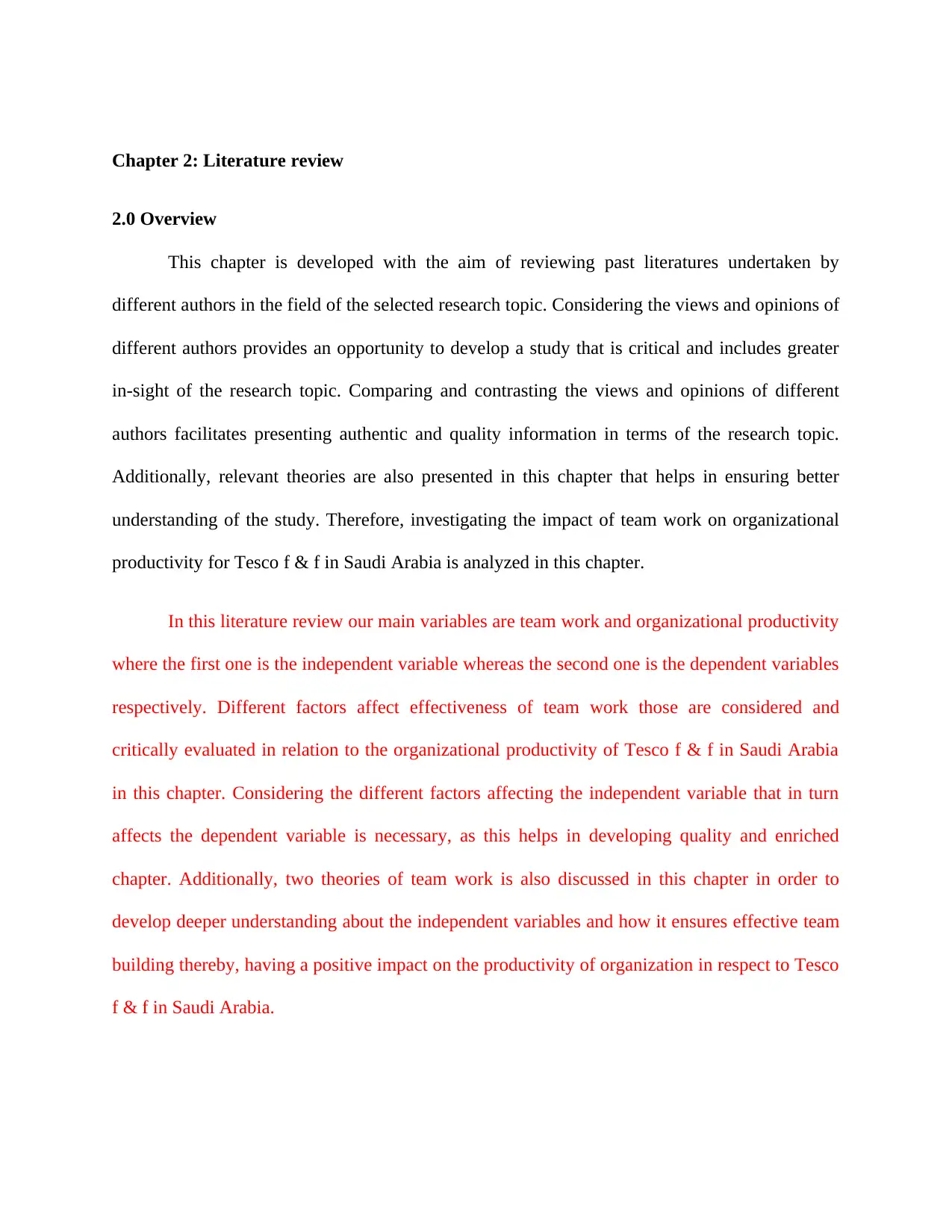
Chapter 2: Literature review
2.0 Overview
This chapter is developed with the aim of reviewing past literatures undertaken by
different authors in the field of the selected research topic. Considering the views and opinions of
different authors provides an opportunity to develop a study that is critical and includes greater
in-sight of the research topic. Comparing and contrasting the views and opinions of different
authors facilitates presenting authentic and quality information in terms of the research topic.
Additionally, relevant theories are also presented in this chapter that helps in ensuring better
understanding of the study. Therefore, investigating the impact of team work on organizational
productivity for Tesco f & f in Saudi Arabia is analyzed in this chapter.
In this literature review our main variables are team work and organizational productivity
where the first one is the independent variable whereas the second one is the dependent variables
respectively. Different factors affect effectiveness of team work those are considered and
critically evaluated in relation to the organizational productivity of Tesco f & f in Saudi Arabia
in this chapter. Considering the different factors affecting the independent variable that in turn
affects the dependent variable is necessary, as this helps in developing quality and enriched
chapter. Additionally, two theories of team work is also discussed in this chapter in order to
develop deeper understanding about the independent variables and how it ensures effective team
building thereby, having a positive impact on the productivity of organization in respect to Tesco
f & f in Saudi Arabia.
2.0 Overview
This chapter is developed with the aim of reviewing past literatures undertaken by
different authors in the field of the selected research topic. Considering the views and opinions of
different authors provides an opportunity to develop a study that is critical and includes greater
in-sight of the research topic. Comparing and contrasting the views and opinions of different
authors facilitates presenting authentic and quality information in terms of the research topic.
Additionally, relevant theories are also presented in this chapter that helps in ensuring better
understanding of the study. Therefore, investigating the impact of team work on organizational
productivity for Tesco f & f in Saudi Arabia is analyzed in this chapter.
In this literature review our main variables are team work and organizational productivity
where the first one is the independent variable whereas the second one is the dependent variables
respectively. Different factors affect effectiveness of team work those are considered and
critically evaluated in relation to the organizational productivity of Tesco f & f in Saudi Arabia
in this chapter. Considering the different factors affecting the independent variable that in turn
affects the dependent variable is necessary, as this helps in developing quality and enriched
chapter. Additionally, two theories of team work is also discussed in this chapter in order to
develop deeper understanding about the independent variables and how it ensures effective team
building thereby, having a positive impact on the productivity of organization in respect to Tesco
f & f in Saudi Arabia.
Paraphrase This Document
Need a fresh take? Get an instant paraphrase of this document with our AI Paraphraser
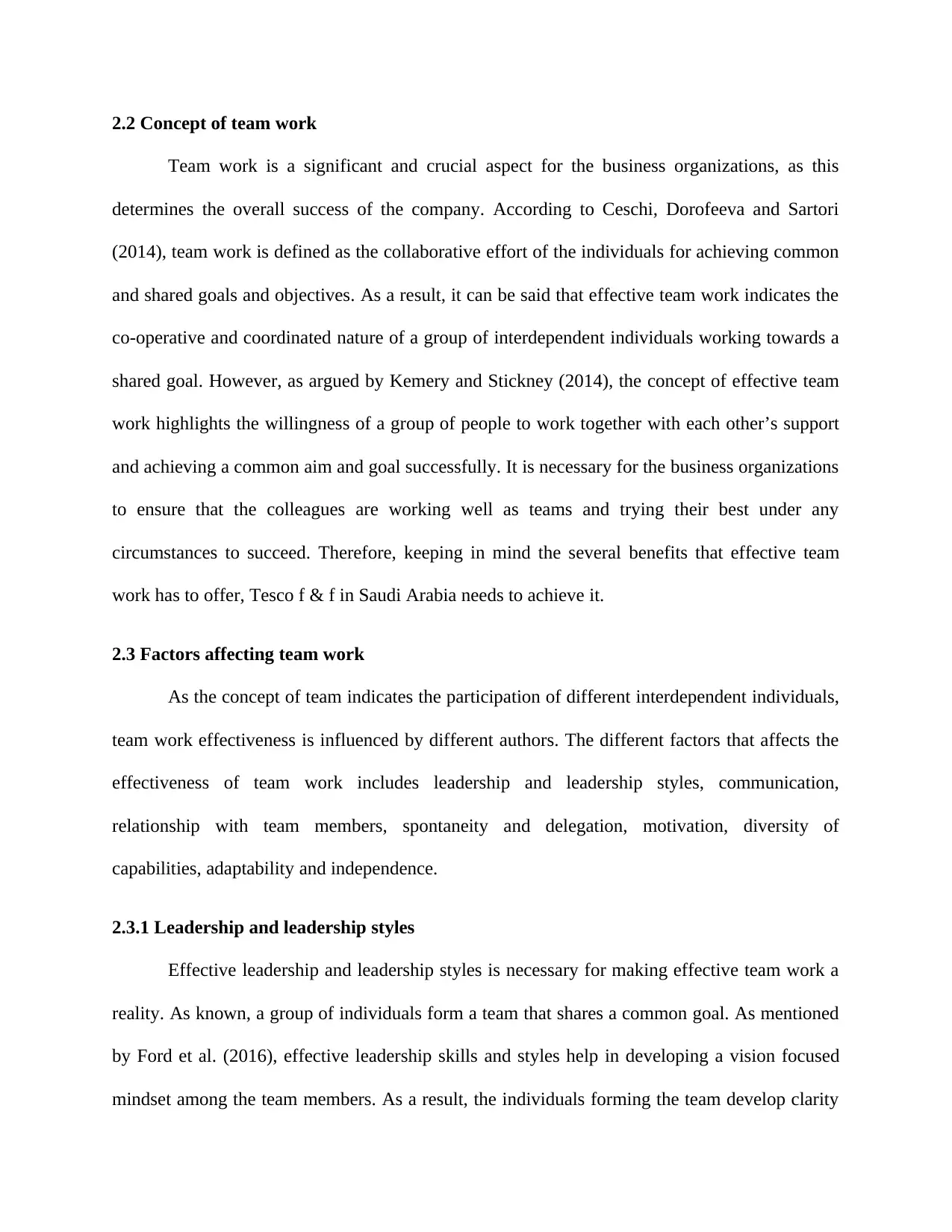
2.2 Concept of team work
Team work is a significant and crucial aspect for the business organizations, as this
determines the overall success of the company. According to Ceschi, Dorofeeva and Sartori
(2014), team work is defined as the collaborative effort of the individuals for achieving common
and shared goals and objectives. As a result, it can be said that effective team work indicates the
co-operative and coordinated nature of a group of interdependent individuals working towards a
shared goal. However, as argued by Kemery and Stickney (2014), the concept of effective team
work highlights the willingness of a group of people to work together with each other’s support
and achieving a common aim and goal successfully. It is necessary for the business organizations
to ensure that the colleagues are working well as teams and trying their best under any
circumstances to succeed. Therefore, keeping in mind the several benefits that effective team
work has to offer, Tesco f & f in Saudi Arabia needs to achieve it.
2.3 Factors affecting team work
As the concept of team indicates the participation of different interdependent individuals,
team work effectiveness is influenced by different authors. The different factors that affects the
effectiveness of team work includes leadership and leadership styles, communication,
relationship with team members, spontaneity and delegation, motivation, diversity of
capabilities, adaptability and independence.
2.3.1 Leadership and leadership styles
Effective leadership and leadership styles is necessary for making effective team work a
reality. As known, a group of individuals form a team that shares a common goal. As mentioned
by Ford et al. (2016), effective leadership skills and styles help in developing a vision focused
mindset among the team members. As a result, the individuals forming the team develop clarity
Team work is a significant and crucial aspect for the business organizations, as this
determines the overall success of the company. According to Ceschi, Dorofeeva and Sartori
(2014), team work is defined as the collaborative effort of the individuals for achieving common
and shared goals and objectives. As a result, it can be said that effective team work indicates the
co-operative and coordinated nature of a group of interdependent individuals working towards a
shared goal. However, as argued by Kemery and Stickney (2014), the concept of effective team
work highlights the willingness of a group of people to work together with each other’s support
and achieving a common aim and goal successfully. It is necessary for the business organizations
to ensure that the colleagues are working well as teams and trying their best under any
circumstances to succeed. Therefore, keeping in mind the several benefits that effective team
work has to offer, Tesco f & f in Saudi Arabia needs to achieve it.
2.3 Factors affecting team work
As the concept of team indicates the participation of different interdependent individuals,
team work effectiveness is influenced by different authors. The different factors that affects the
effectiveness of team work includes leadership and leadership styles, communication,
relationship with team members, spontaneity and delegation, motivation, diversity of
capabilities, adaptability and independence.
2.3.1 Leadership and leadership styles
Effective leadership and leadership styles is necessary for making effective team work a
reality. As known, a group of individuals form a team that shares a common goal. As mentioned
by Ford et al. (2016), effective leadership skills and styles help in developing a vision focused
mindset among the team members. As a result, the individuals forming the team develop clarity
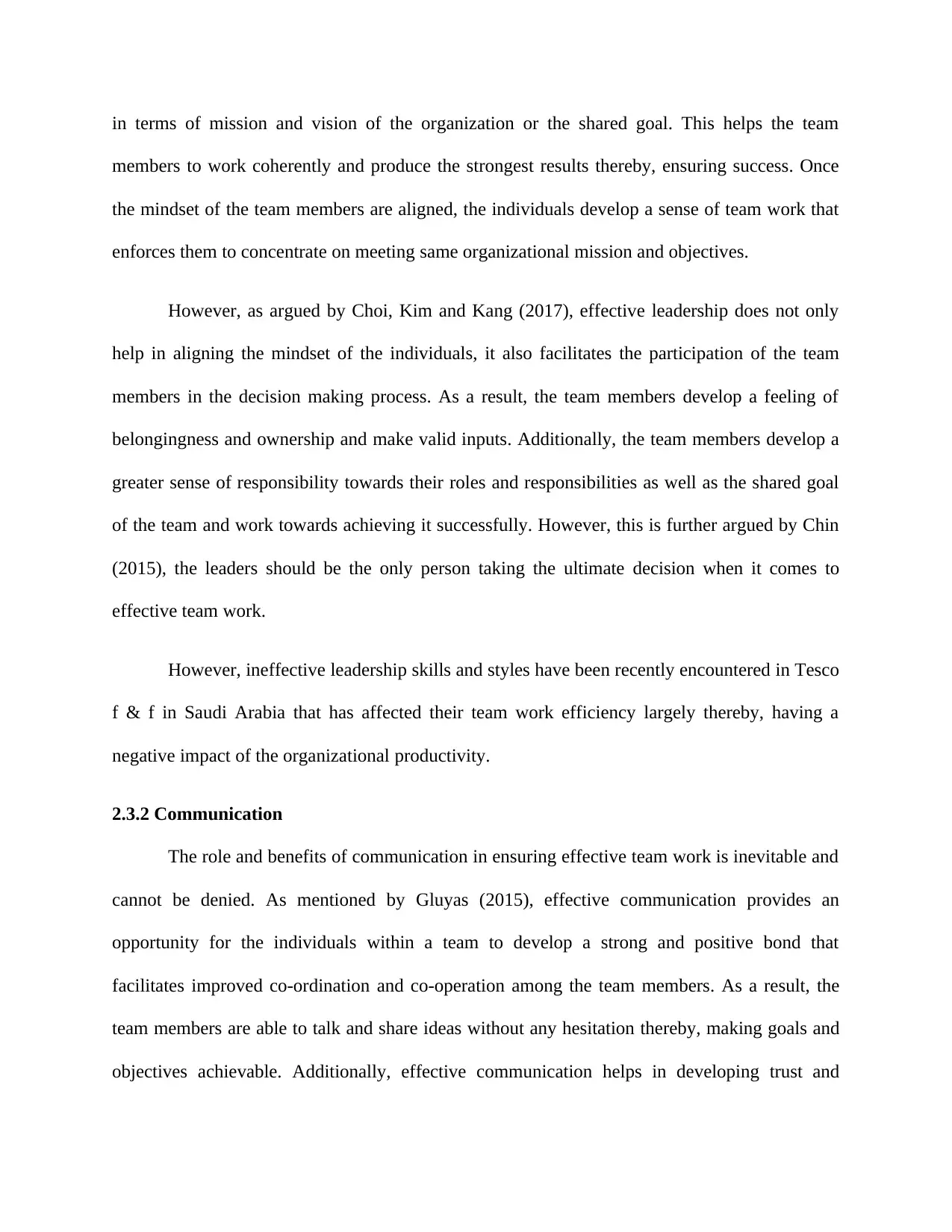
in terms of mission and vision of the organization or the shared goal. This helps the team
members to work coherently and produce the strongest results thereby, ensuring success. Once
the mindset of the team members are aligned, the individuals develop a sense of team work that
enforces them to concentrate on meeting same organizational mission and objectives.
However, as argued by Choi, Kim and Kang (2017), effective leadership does not only
help in aligning the mindset of the individuals, it also facilitates the participation of the team
members in the decision making process. As a result, the team members develop a feeling of
belongingness and ownership and make valid inputs. Additionally, the team members develop a
greater sense of responsibility towards their roles and responsibilities as well as the shared goal
of the team and work towards achieving it successfully. However, this is further argued by Chin
(2015), the leaders should be the only person taking the ultimate decision when it comes to
effective team work.
However, ineffective leadership skills and styles have been recently encountered in Tesco
f & f in Saudi Arabia that has affected their team work efficiency largely thereby, having a
negative impact of the organizational productivity.
2.3.2 Communication
The role and benefits of communication in ensuring effective team work is inevitable and
cannot be denied. As mentioned by Gluyas (2015), effective communication provides an
opportunity for the individuals within a team to develop a strong and positive bond that
facilitates improved co-ordination and co-operation among the team members. As a result, the
team members are able to talk and share ideas without any hesitation thereby, making goals and
objectives achievable. Additionally, effective communication helps in developing trust and
members to work coherently and produce the strongest results thereby, ensuring success. Once
the mindset of the team members are aligned, the individuals develop a sense of team work that
enforces them to concentrate on meeting same organizational mission and objectives.
However, as argued by Choi, Kim and Kang (2017), effective leadership does not only
help in aligning the mindset of the individuals, it also facilitates the participation of the team
members in the decision making process. As a result, the team members develop a feeling of
belongingness and ownership and make valid inputs. Additionally, the team members develop a
greater sense of responsibility towards their roles and responsibilities as well as the shared goal
of the team and work towards achieving it successfully. However, this is further argued by Chin
(2015), the leaders should be the only person taking the ultimate decision when it comes to
effective team work.
However, ineffective leadership skills and styles have been recently encountered in Tesco
f & f in Saudi Arabia that has affected their team work efficiency largely thereby, having a
negative impact of the organizational productivity.
2.3.2 Communication
The role and benefits of communication in ensuring effective team work is inevitable and
cannot be denied. As mentioned by Gluyas (2015), effective communication provides an
opportunity for the individuals within a team to develop a strong and positive bond that
facilitates improved co-ordination and co-operation among the team members. As a result, the
team members are able to talk and share ideas without any hesitation thereby, making goals and
objectives achievable. Additionally, effective communication helps in developing trust and
⊘ This is a preview!⊘
Do you want full access?
Subscribe today to unlock all pages.

Trusted by 1+ million students worldwide
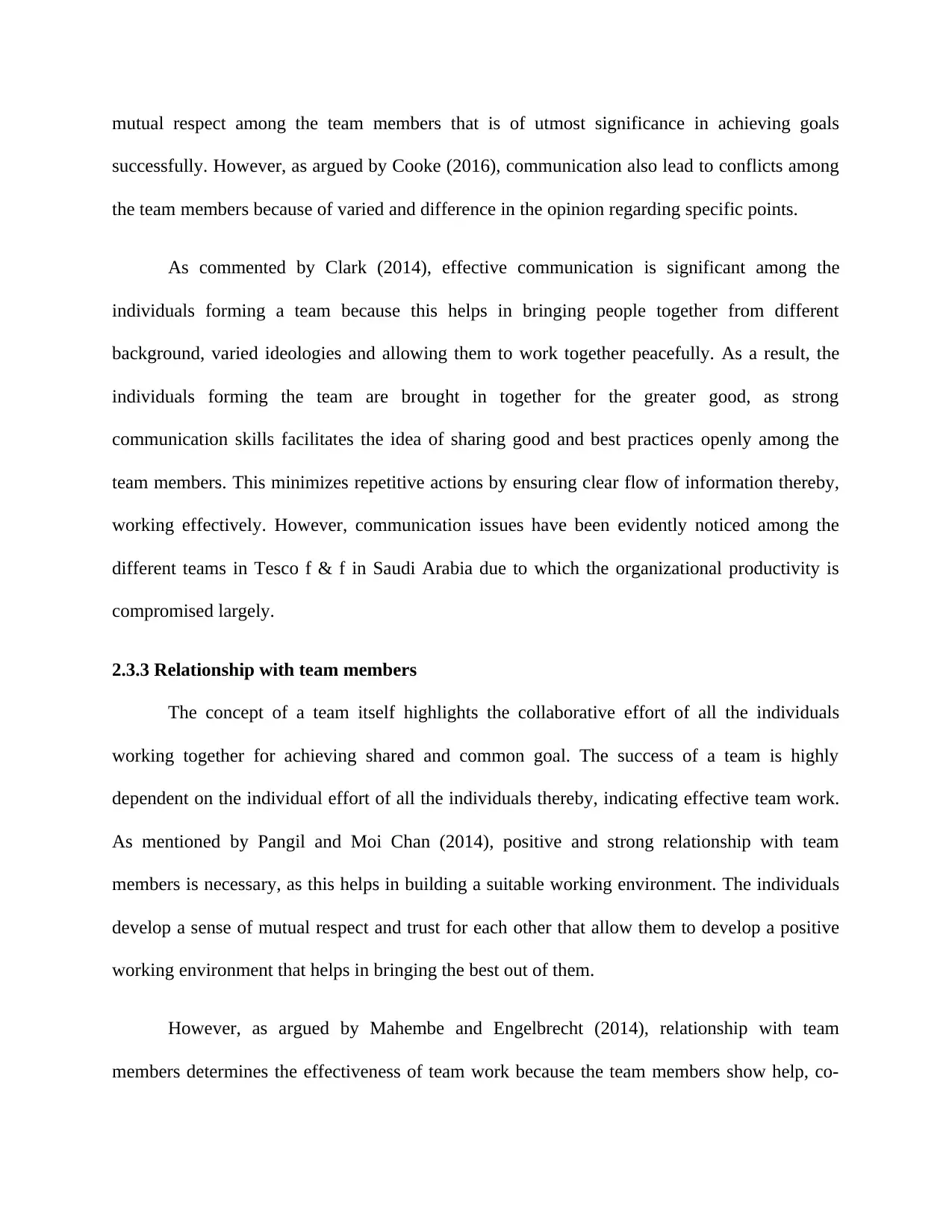
mutual respect among the team members that is of utmost significance in achieving goals
successfully. However, as argued by Cooke (2016), communication also lead to conflicts among
the team members because of varied and difference in the opinion regarding specific points.
As commented by Clark (2014), effective communication is significant among the
individuals forming a team because this helps in bringing people together from different
background, varied ideologies and allowing them to work together peacefully. As a result, the
individuals forming the team are brought in together for the greater good, as strong
communication skills facilitates the idea of sharing good and best practices openly among the
team members. This minimizes repetitive actions by ensuring clear flow of information thereby,
working effectively. However, communication issues have been evidently noticed among the
different teams in Tesco f & f in Saudi Arabia due to which the organizational productivity is
compromised largely.
2.3.3 Relationship with team members
The concept of a team itself highlights the collaborative effort of all the individuals
working together for achieving shared and common goal. The success of a team is highly
dependent on the individual effort of all the individuals thereby, indicating effective team work.
As mentioned by Pangil and Moi Chan (2014), positive and strong relationship with team
members is necessary, as this helps in building a suitable working environment. The individuals
develop a sense of mutual respect and trust for each other that allow them to develop a positive
working environment that helps in bringing the best out of them.
However, as argued by Mahembe and Engelbrecht (2014), relationship with team
members determines the effectiveness of team work because the team members show help, co-
successfully. However, as argued by Cooke (2016), communication also lead to conflicts among
the team members because of varied and difference in the opinion regarding specific points.
As commented by Clark (2014), effective communication is significant among the
individuals forming a team because this helps in bringing people together from different
background, varied ideologies and allowing them to work together peacefully. As a result, the
individuals forming the team are brought in together for the greater good, as strong
communication skills facilitates the idea of sharing good and best practices openly among the
team members. This minimizes repetitive actions by ensuring clear flow of information thereby,
working effectively. However, communication issues have been evidently noticed among the
different teams in Tesco f & f in Saudi Arabia due to which the organizational productivity is
compromised largely.
2.3.3 Relationship with team members
The concept of a team itself highlights the collaborative effort of all the individuals
working together for achieving shared and common goal. The success of a team is highly
dependent on the individual effort of all the individuals thereby, indicating effective team work.
As mentioned by Pangil and Moi Chan (2014), positive and strong relationship with team
members is necessary, as this helps in building a suitable working environment. The individuals
develop a sense of mutual respect and trust for each other that allow them to develop a positive
working environment that helps in bringing the best out of them.
However, as argued by Mahembe and Engelbrecht (2014), relationship with team
members determines the effectiveness of team work because the team members show help, co-
Paraphrase This Document
Need a fresh take? Get an instant paraphrase of this document with our AI Paraphraser
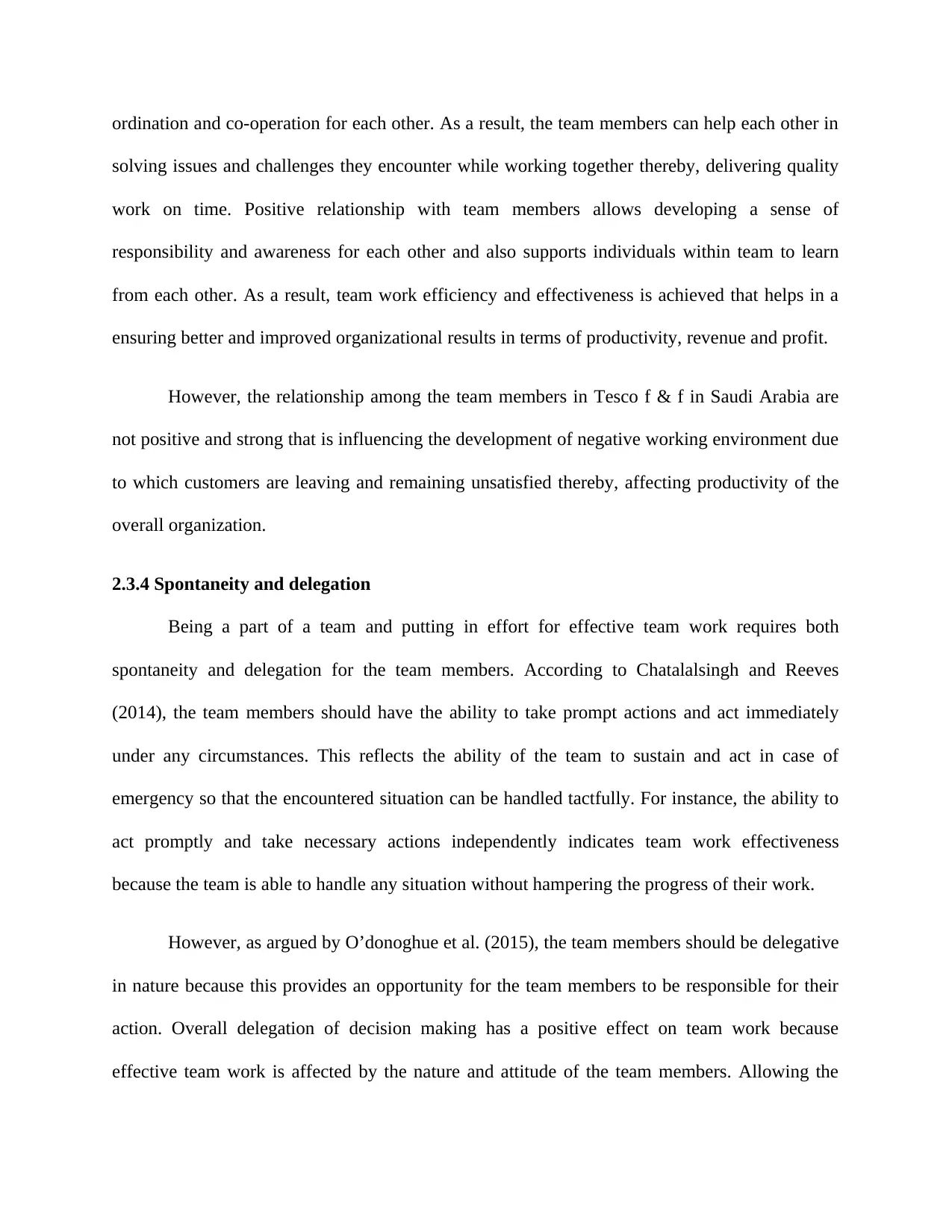
ordination and co-operation for each other. As a result, the team members can help each other in
solving issues and challenges they encounter while working together thereby, delivering quality
work on time. Positive relationship with team members allows developing a sense of
responsibility and awareness for each other and also supports individuals within team to learn
from each other. As a result, team work efficiency and effectiveness is achieved that helps in a
ensuring better and improved organizational results in terms of productivity, revenue and profit.
However, the relationship among the team members in Tesco f & f in Saudi Arabia are
not positive and strong that is influencing the development of negative working environment due
to which customers are leaving and remaining unsatisfied thereby, affecting productivity of the
overall organization.
2.3.4 Spontaneity and delegation
Being a part of a team and putting in effort for effective team work requires both
spontaneity and delegation for the team members. According to Chatalalsingh and Reeves
(2014), the team members should have the ability to take prompt actions and act immediately
under any circumstances. This reflects the ability of the team to sustain and act in case of
emergency so that the encountered situation can be handled tactfully. For instance, the ability to
act promptly and take necessary actions independently indicates team work effectiveness
because the team is able to handle any situation without hampering the progress of their work.
However, as argued by O’donoghue et al. (2015), the team members should be delegative
in nature because this provides an opportunity for the team members to be responsible for their
action. Overall delegation of decision making has a positive effect on team work because
effective team work is affected by the nature and attitude of the team members. Allowing the
solving issues and challenges they encounter while working together thereby, delivering quality
work on time. Positive relationship with team members allows developing a sense of
responsibility and awareness for each other and also supports individuals within team to learn
from each other. As a result, team work efficiency and effectiveness is achieved that helps in a
ensuring better and improved organizational results in terms of productivity, revenue and profit.
However, the relationship among the team members in Tesco f & f in Saudi Arabia are
not positive and strong that is influencing the development of negative working environment due
to which customers are leaving and remaining unsatisfied thereby, affecting productivity of the
overall organization.
2.3.4 Spontaneity and delegation
Being a part of a team and putting in effort for effective team work requires both
spontaneity and delegation for the team members. According to Chatalalsingh and Reeves
(2014), the team members should have the ability to take prompt actions and act immediately
under any circumstances. This reflects the ability of the team to sustain and act in case of
emergency so that the encountered situation can be handled tactfully. For instance, the ability to
act promptly and take necessary actions independently indicates team work effectiveness
because the team is able to handle any situation without hampering the progress of their work.
However, as argued by O’donoghue et al. (2015), the team members should be delegative
in nature because this provides an opportunity for the team members to be responsible for their
action. Overall delegation of decision making has a positive effect on team work because
effective team work is affected by the nature and attitude of the team members. Allowing the

team members to share their views and opinions and take part in the decision making process
ensures efficient team work that has a positive impact on the overall organizational productivity
because this ensures motivating others and establishing adequate control of individual as well as
group roles and responsibilities.
However, for both spontaneity and delegation has become a major issue for Tesco f & f
in Saudi Arabia due to which the organizations is failing to live up to market expectations and
provide services efficiently thereby, having a negative impact.
2.3.5 Motivation
The role of motivation in ensuring effective team work is inevitable and business
organizations should focus in motivating the team members appropriately. According to HU and
Liden (2015), adequate motivation can help the team members to communicate effectively with
the fellow team members. This helps in ensuring clear flow of information within the team that
prohibits repetitive actions and maintaining smooth work flow. The team members can keep
track on the latest developments going on within the team followed by circulating the
information all around the team. As a result, the teams achieve greater heights that indicate
effective team work. However, as argued by Costa, Passos and Bakker (2014), motivating the
team members is essential, as this helps in encouraging the team members in creating a positive
working environment, facilitating co-operation and support and promoting healthy competition
with the team thereby, providing opportunities for development. As a result, the effective team
work is highlighted because the employees feel satisfied with their roles and responsibilities that
is highly beneficial for the overall organization.
ensures efficient team work that has a positive impact on the overall organizational productivity
because this ensures motivating others and establishing adequate control of individual as well as
group roles and responsibilities.
However, for both spontaneity and delegation has become a major issue for Tesco f & f
in Saudi Arabia due to which the organizations is failing to live up to market expectations and
provide services efficiently thereby, having a negative impact.
2.3.5 Motivation
The role of motivation in ensuring effective team work is inevitable and business
organizations should focus in motivating the team members appropriately. According to HU and
Liden (2015), adequate motivation can help the team members to communicate effectively with
the fellow team members. This helps in ensuring clear flow of information within the team that
prohibits repetitive actions and maintaining smooth work flow. The team members can keep
track on the latest developments going on within the team followed by circulating the
information all around the team. As a result, the teams achieve greater heights that indicate
effective team work. However, as argued by Costa, Passos and Bakker (2014), motivating the
team members is essential, as this helps in encouraging the team members in creating a positive
working environment, facilitating co-operation and support and promoting healthy competition
with the team thereby, providing opportunities for development. As a result, the effective team
work is highlighted because the employees feel satisfied with their roles and responsibilities that
is highly beneficial for the overall organization.
⊘ This is a preview!⊘
Do you want full access?
Subscribe today to unlock all pages.

Trusted by 1+ million students worldwide

However, situation is completely opposite for Tesco f & f in Saudi Arabia where the team
members lack adequate motivation that is imposing a negative impact on the productivity of the
organization because of inefficient and inappropriate services compared to the competitors.
2.3.6 Diversity of capabilities
The effectiveness and success of team work is also influenced by the diversity of the
capabilities among the team members. As commented by Van Knippenberg and Mell (2016), a
team should comprise of members having wide range of capabilities, skills and expertise. This
increases the ability of the teams because they are able to handle wide range of roles and
responsibilities due to existence of diversified talent pool. The teams do not have to take help
and assistance from others and yet complete different tasks that come across them while
achieving goals and objectives. Each team member can use their strengths and help others
overcome their weakness in order to achieve organizational or project goals and objectives
without relying on others thereby, ensuring effective team work. However, as criticized by Zhou
and Rosini (2015), the team members should be aware of their talents and have the ability to
excise and use their talents for effective team work. The team members should have a giving and
helping nature towards the team members that facilitate positive and healthy working
environment.
However, issues in managing talent diversity have been evidently noticed within the
teams in Tesco f & f in Saudi Arabia due to which the organizational productivity is
compromised largely.
members lack adequate motivation that is imposing a negative impact on the productivity of the
organization because of inefficient and inappropriate services compared to the competitors.
2.3.6 Diversity of capabilities
The effectiveness and success of team work is also influenced by the diversity of the
capabilities among the team members. As commented by Van Knippenberg and Mell (2016), a
team should comprise of members having wide range of capabilities, skills and expertise. This
increases the ability of the teams because they are able to handle wide range of roles and
responsibilities due to existence of diversified talent pool. The teams do not have to take help
and assistance from others and yet complete different tasks that come across them while
achieving goals and objectives. Each team member can use their strengths and help others
overcome their weakness in order to achieve organizational or project goals and objectives
without relying on others thereby, ensuring effective team work. However, as criticized by Zhou
and Rosini (2015), the team members should be aware of their talents and have the ability to
excise and use their talents for effective team work. The team members should have a giving and
helping nature towards the team members that facilitate positive and healthy working
environment.
However, issues in managing talent diversity have been evidently noticed within the
teams in Tesco f & f in Saudi Arabia due to which the organizational productivity is
compromised largely.
Paraphrase This Document
Need a fresh take? Get an instant paraphrase of this document with our AI Paraphraser
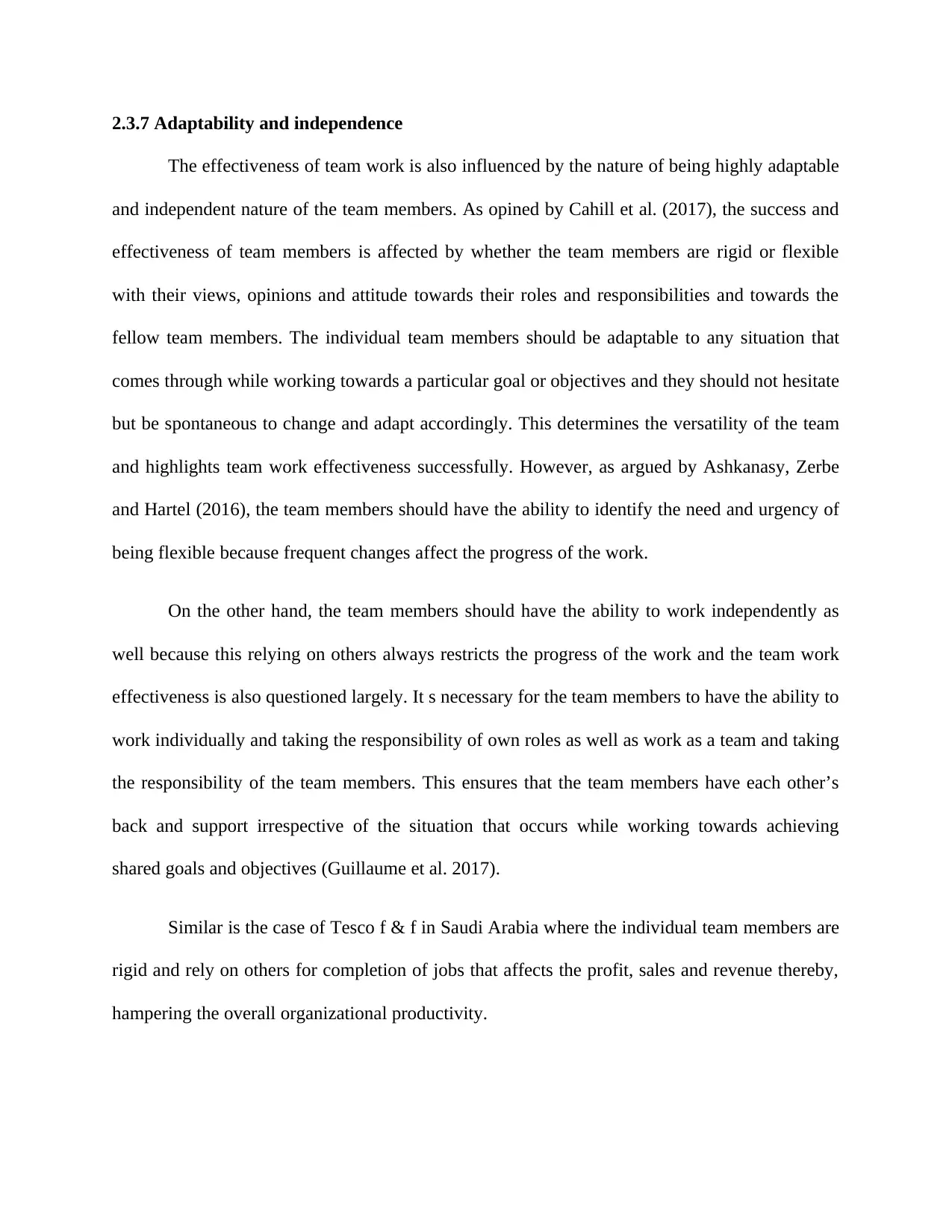
2.3.7 Adaptability and independence
The effectiveness of team work is also influenced by the nature of being highly adaptable
and independent nature of the team members. As opined by Cahill et al. (2017), the success and
effectiveness of team members is affected by whether the team members are rigid or flexible
with their views, opinions and attitude towards their roles and responsibilities and towards the
fellow team members. The individual team members should be adaptable to any situation that
comes through while working towards a particular goal or objectives and they should not hesitate
but be spontaneous to change and adapt accordingly. This determines the versatility of the team
and highlights team work effectiveness successfully. However, as argued by Ashkanasy, Zerbe
and Hartel (2016), the team members should have the ability to identify the need and urgency of
being flexible because frequent changes affect the progress of the work.
On the other hand, the team members should have the ability to work independently as
well because this relying on others always restricts the progress of the work and the team work
effectiveness is also questioned largely. It s necessary for the team members to have the ability to
work individually and taking the responsibility of own roles as well as work as a team and taking
the responsibility of the team members. This ensures that the team members have each other’s
back and support irrespective of the situation that occurs while working towards achieving
shared goals and objectives (Guillaume et al. 2017).
Similar is the case of Tesco f & f in Saudi Arabia where the individual team members are
rigid and rely on others for completion of jobs that affects the profit, sales and revenue thereby,
hampering the overall organizational productivity.
The effectiveness of team work is also influenced by the nature of being highly adaptable
and independent nature of the team members. As opined by Cahill et al. (2017), the success and
effectiveness of team members is affected by whether the team members are rigid or flexible
with their views, opinions and attitude towards their roles and responsibilities and towards the
fellow team members. The individual team members should be adaptable to any situation that
comes through while working towards a particular goal or objectives and they should not hesitate
but be spontaneous to change and adapt accordingly. This determines the versatility of the team
and highlights team work effectiveness successfully. However, as argued by Ashkanasy, Zerbe
and Hartel (2016), the team members should have the ability to identify the need and urgency of
being flexible because frequent changes affect the progress of the work.
On the other hand, the team members should have the ability to work independently as
well because this relying on others always restricts the progress of the work and the team work
effectiveness is also questioned largely. It s necessary for the team members to have the ability to
work individually and taking the responsibility of own roles as well as work as a team and taking
the responsibility of the team members. This ensures that the team members have each other’s
back and support irrespective of the situation that occurs while working towards achieving
shared goals and objectives (Guillaume et al. 2017).
Similar is the case of Tesco f & f in Saudi Arabia where the individual team members are
rigid and rely on others for completion of jobs that affects the profit, sales and revenue thereby,
hampering the overall organizational productivity.
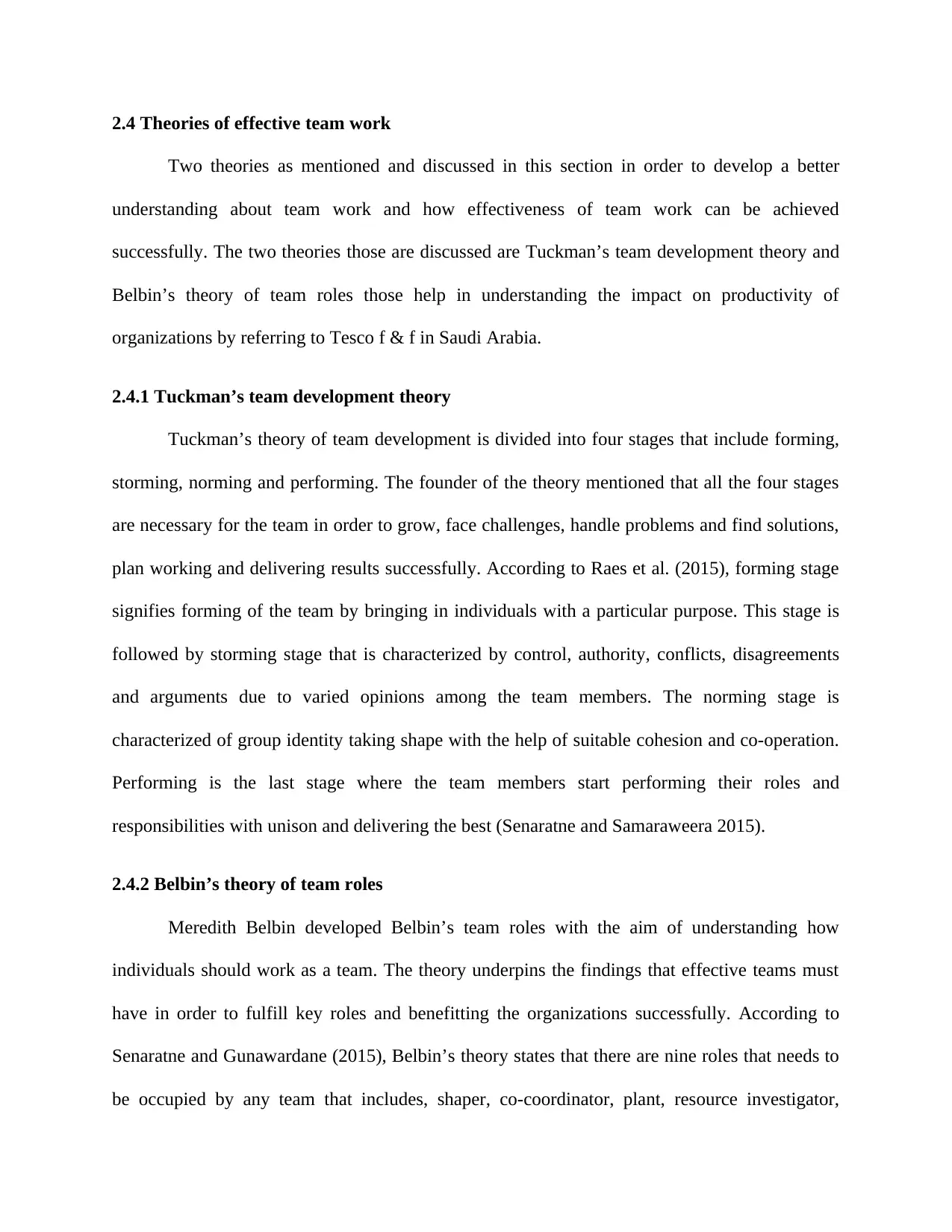
2.4 Theories of effective team work
Two theories as mentioned and discussed in this section in order to develop a better
understanding about team work and how effectiveness of team work can be achieved
successfully. The two theories those are discussed are Tuckman’s team development theory and
Belbin’s theory of team roles those help in understanding the impact on productivity of
organizations by referring to Tesco f & f in Saudi Arabia.
2.4.1 Tuckman’s team development theory
Tuckman’s theory of team development is divided into four stages that include forming,
storming, norming and performing. The founder of the theory mentioned that all the four stages
are necessary for the team in order to grow, face challenges, handle problems and find solutions,
plan working and delivering results successfully. According to Raes et al. (2015), forming stage
signifies forming of the team by bringing in individuals with a particular purpose. This stage is
followed by storming stage that is characterized by control, authority, conflicts, disagreements
and arguments due to varied opinions among the team members. The norming stage is
characterized of group identity taking shape with the help of suitable cohesion and co-operation.
Performing is the last stage where the team members start performing their roles and
responsibilities with unison and delivering the best (Senaratne and Samaraweera 2015).
2.4.2 Belbin’s theory of team roles
Meredith Belbin developed Belbin’s team roles with the aim of understanding how
individuals should work as a team. The theory underpins the findings that effective teams must
have in order to fulfill key roles and benefitting the organizations successfully. According to
Senaratne and Gunawardane (2015), Belbin’s theory states that there are nine roles that needs to
be occupied by any team that includes, shaper, co-coordinator, plant, resource investigator,
Two theories as mentioned and discussed in this section in order to develop a better
understanding about team work and how effectiveness of team work can be achieved
successfully. The two theories those are discussed are Tuckman’s team development theory and
Belbin’s theory of team roles those help in understanding the impact on productivity of
organizations by referring to Tesco f & f in Saudi Arabia.
2.4.1 Tuckman’s team development theory
Tuckman’s theory of team development is divided into four stages that include forming,
storming, norming and performing. The founder of the theory mentioned that all the four stages
are necessary for the team in order to grow, face challenges, handle problems and find solutions,
plan working and delivering results successfully. According to Raes et al. (2015), forming stage
signifies forming of the team by bringing in individuals with a particular purpose. This stage is
followed by storming stage that is characterized by control, authority, conflicts, disagreements
and arguments due to varied opinions among the team members. The norming stage is
characterized of group identity taking shape with the help of suitable cohesion and co-operation.
Performing is the last stage where the team members start performing their roles and
responsibilities with unison and delivering the best (Senaratne and Samaraweera 2015).
2.4.2 Belbin’s theory of team roles
Meredith Belbin developed Belbin’s team roles with the aim of understanding how
individuals should work as a team. The theory underpins the findings that effective teams must
have in order to fulfill key roles and benefitting the organizations successfully. According to
Senaratne and Gunawardane (2015), Belbin’s theory states that there are nine roles that needs to
be occupied by any team that includes, shaper, co-coordinator, plant, resource investigator,
⊘ This is a preview!⊘
Do you want full access?
Subscribe today to unlock all pages.

Trusted by 1+ million students worldwide
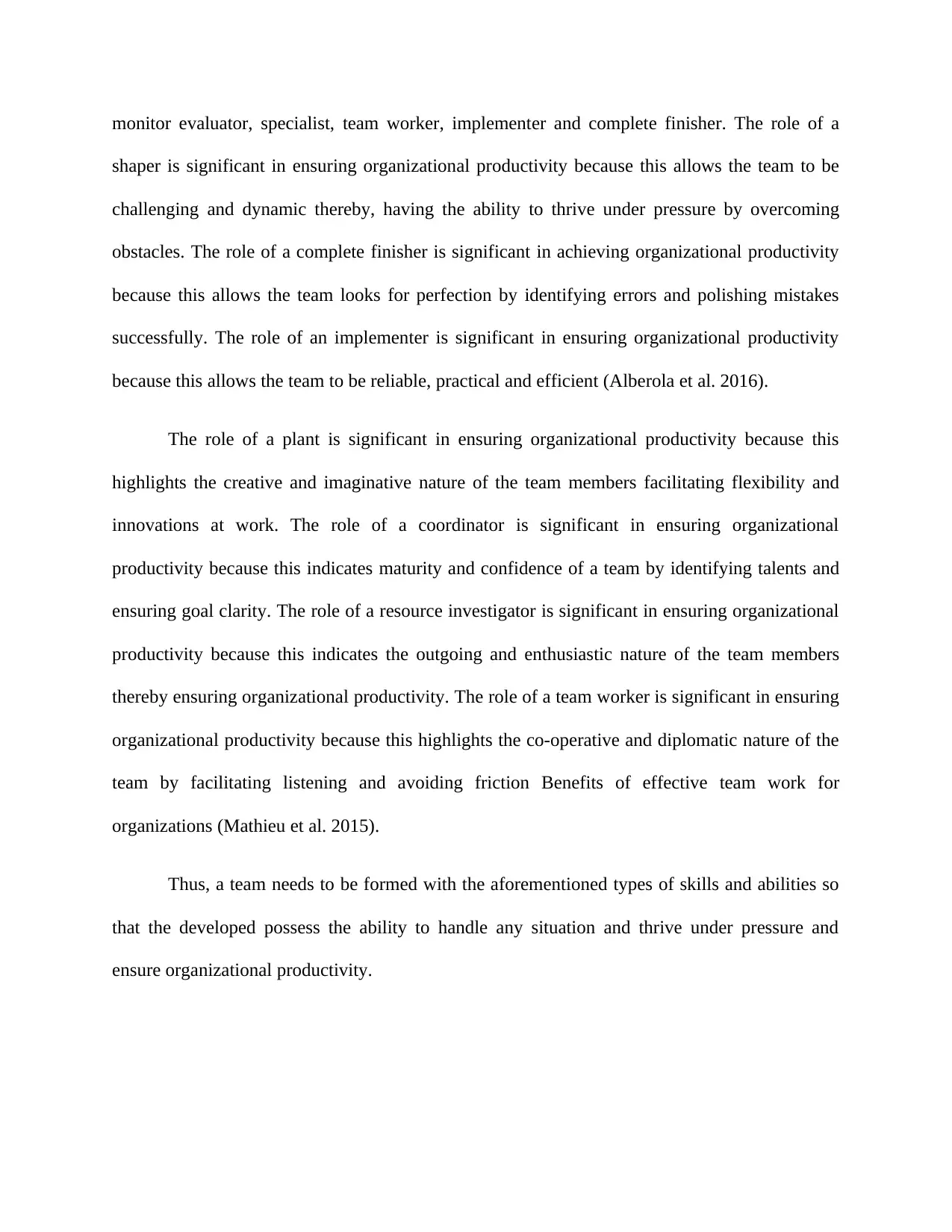
monitor evaluator, specialist, team worker, implementer and complete finisher. The role of a
shaper is significant in ensuring organizational productivity because this allows the team to be
challenging and dynamic thereby, having the ability to thrive under pressure by overcoming
obstacles. The role of a complete finisher is significant in achieving organizational productivity
because this allows the team looks for perfection by identifying errors and polishing mistakes
successfully. The role of an implementer is significant in ensuring organizational productivity
because this allows the team to be reliable, practical and efficient (Alberola et al. 2016).
The role of a plant is significant in ensuring organizational productivity because this
highlights the creative and imaginative nature of the team members facilitating flexibility and
innovations at work. The role of a coordinator is significant in ensuring organizational
productivity because this indicates maturity and confidence of a team by identifying talents and
ensuring goal clarity. The role of a resource investigator is significant in ensuring organizational
productivity because this indicates the outgoing and enthusiastic nature of the team members
thereby ensuring organizational productivity. The role of a team worker is significant in ensuring
organizational productivity because this highlights the co-operative and diplomatic nature of the
team by facilitating listening and avoiding friction Benefits of effective team work for
organizations (Mathieu et al. 2015).
Thus, a team needs to be formed with the aforementioned types of skills and abilities so
that the developed possess the ability to handle any situation and thrive under pressure and
ensure organizational productivity.
shaper is significant in ensuring organizational productivity because this allows the team to be
challenging and dynamic thereby, having the ability to thrive under pressure by overcoming
obstacles. The role of a complete finisher is significant in achieving organizational productivity
because this allows the team looks for perfection by identifying errors and polishing mistakes
successfully. The role of an implementer is significant in ensuring organizational productivity
because this allows the team to be reliable, practical and efficient (Alberola et al. 2016).
The role of a plant is significant in ensuring organizational productivity because this
highlights the creative and imaginative nature of the team members facilitating flexibility and
innovations at work. The role of a coordinator is significant in ensuring organizational
productivity because this indicates maturity and confidence of a team by identifying talents and
ensuring goal clarity. The role of a resource investigator is significant in ensuring organizational
productivity because this indicates the outgoing and enthusiastic nature of the team members
thereby ensuring organizational productivity. The role of a team worker is significant in ensuring
organizational productivity because this highlights the co-operative and diplomatic nature of the
team by facilitating listening and avoiding friction Benefits of effective team work for
organizations (Mathieu et al. 2015).
Thus, a team needs to be formed with the aforementioned types of skills and abilities so
that the developed possess the ability to handle any situation and thrive under pressure and
ensure organizational productivity.
Paraphrase This Document
Need a fresh take? Get an instant paraphrase of this document with our AI Paraphraser
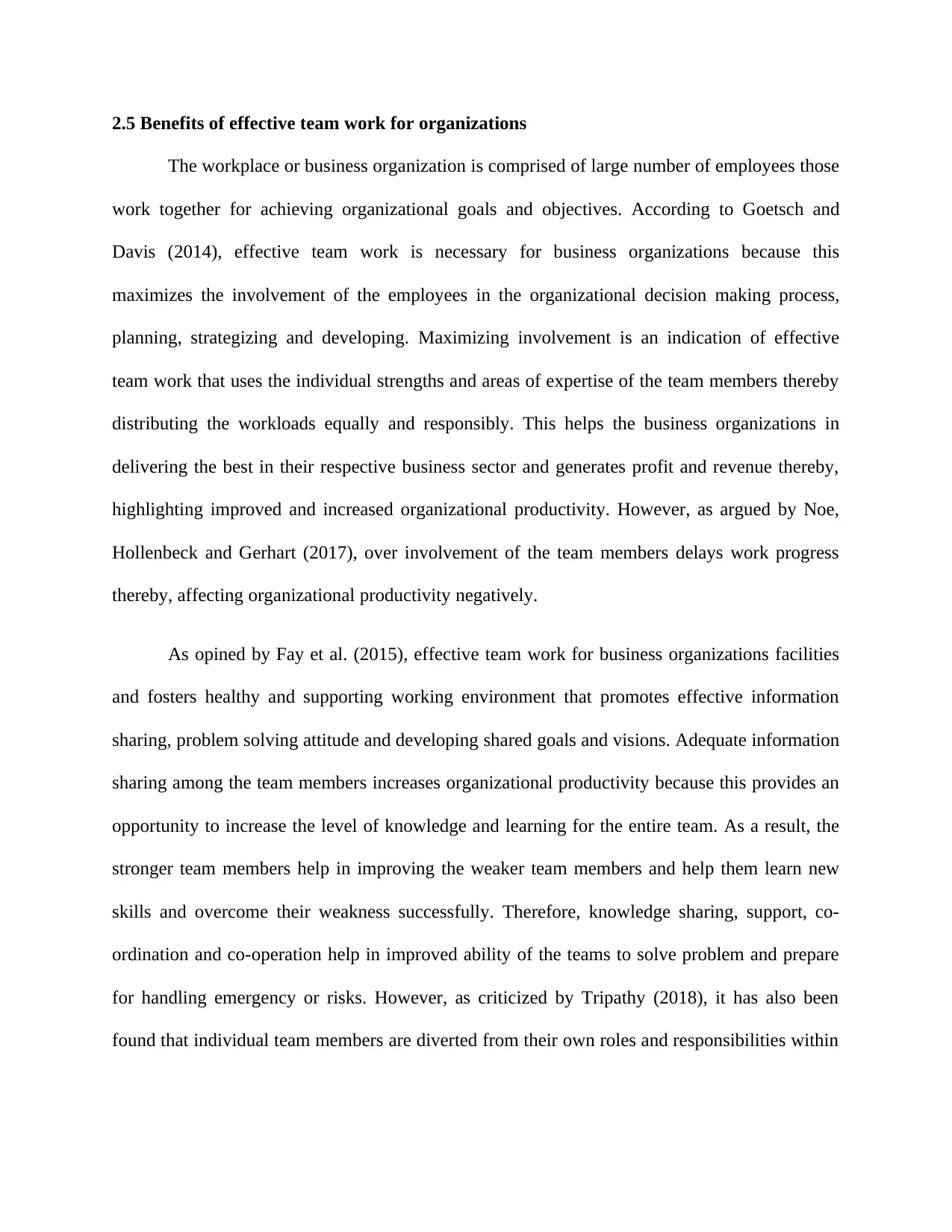
2.5 Benefits of effective team work for organizations
The workplace or business organization is comprised of large number of employees those
work together for achieving organizational goals and objectives. According to Goetsch and
Davis (2014), effective team work is necessary for business organizations because this
maximizes the involvement of the employees in the organizational decision making process,
planning, strategizing and developing. Maximizing involvement is an indication of effective
team work that uses the individual strengths and areas of expertise of the team members thereby
distributing the workloads equally and responsibly. This helps the business organizations in
delivering the best in their respective business sector and generates profit and revenue thereby,
highlighting improved and increased organizational productivity. However, as argued by Noe,
Hollenbeck and Gerhart (2017), over involvement of the team members delays work progress
thereby, affecting organizational productivity negatively.
As opined by Fay et al. (2015), effective team work for business organizations facilities
and fosters healthy and supporting working environment that promotes effective information
sharing, problem solving attitude and developing shared goals and visions. Adequate information
sharing among the team members increases organizational productivity because this provides an
opportunity to increase the level of knowledge and learning for the entire team. As a result, the
stronger team members help in improving the weaker team members and help them learn new
skills and overcome their weakness successfully. Therefore, knowledge sharing, support, co-
ordination and co-operation help in improved ability of the teams to solve problem and prepare
for handling emergency or risks. However, as criticized by Tripathy (2018), it has also been
found that individual team members are diverted from their own roles and responsibilities within
The workplace or business organization is comprised of large number of employees those
work together for achieving organizational goals and objectives. According to Goetsch and
Davis (2014), effective team work is necessary for business organizations because this
maximizes the involvement of the employees in the organizational decision making process,
planning, strategizing and developing. Maximizing involvement is an indication of effective
team work that uses the individual strengths and areas of expertise of the team members thereby
distributing the workloads equally and responsibly. This helps the business organizations in
delivering the best in their respective business sector and generates profit and revenue thereby,
highlighting improved and increased organizational productivity. However, as argued by Noe,
Hollenbeck and Gerhart (2017), over involvement of the team members delays work progress
thereby, affecting organizational productivity negatively.
As opined by Fay et al. (2015), effective team work for business organizations facilities
and fosters healthy and supporting working environment that promotes effective information
sharing, problem solving attitude and developing shared goals and visions. Adequate information
sharing among the team members increases organizational productivity because this provides an
opportunity to increase the level of knowledge and learning for the entire team. As a result, the
stronger team members help in improving the weaker team members and help them learn new
skills and overcome their weakness successfully. Therefore, knowledge sharing, support, co-
ordination and co-operation help in improved ability of the teams to solve problem and prepare
for handling emergency or risks. However, as criticized by Tripathy (2018), it has also been
found that individual team members are diverted from their own roles and responsibilities within
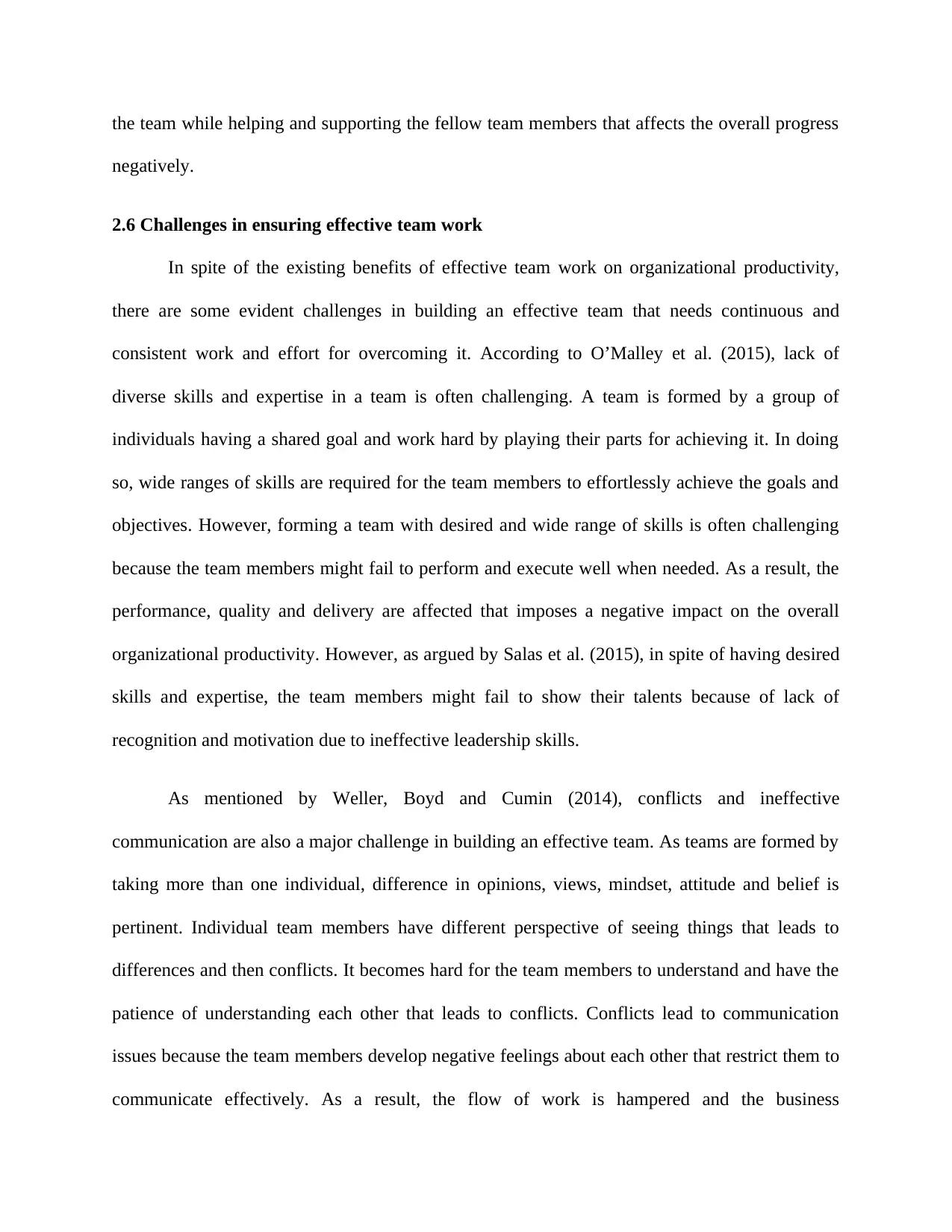
the team while helping and supporting the fellow team members that affects the overall progress
negatively.
2.6 Challenges in ensuring effective team work
In spite of the existing benefits of effective team work on organizational productivity,
there are some evident challenges in building an effective team that needs continuous and
consistent work and effort for overcoming it. According to O’Malley et al. (2015), lack of
diverse skills and expertise in a team is often challenging. A team is formed by a group of
individuals having a shared goal and work hard by playing their parts for achieving it. In doing
so, wide ranges of skills are required for the team members to effortlessly achieve the goals and
objectives. However, forming a team with desired and wide range of skills is often challenging
because the team members might fail to perform and execute well when needed. As a result, the
performance, quality and delivery are affected that imposes a negative impact on the overall
organizational productivity. However, as argued by Salas et al. (2015), in spite of having desired
skills and expertise, the team members might fail to show their talents because of lack of
recognition and motivation due to ineffective leadership skills.
As mentioned by Weller, Boyd and Cumin (2014), conflicts and ineffective
communication are also a major challenge in building an effective team. As teams are formed by
taking more than one individual, difference in opinions, views, mindset, attitude and belief is
pertinent. Individual team members have different perspective of seeing things that leads to
differences and then conflicts. It becomes hard for the team members to understand and have the
patience of understanding each other that leads to conflicts. Conflicts lead to communication
issues because the team members develop negative feelings about each other that restrict them to
communicate effectively. As a result, the flow of work is hampered and the business
negatively.
2.6 Challenges in ensuring effective team work
In spite of the existing benefits of effective team work on organizational productivity,
there are some evident challenges in building an effective team that needs continuous and
consistent work and effort for overcoming it. According to O’Malley et al. (2015), lack of
diverse skills and expertise in a team is often challenging. A team is formed by a group of
individuals having a shared goal and work hard by playing their parts for achieving it. In doing
so, wide ranges of skills are required for the team members to effortlessly achieve the goals and
objectives. However, forming a team with desired and wide range of skills is often challenging
because the team members might fail to perform and execute well when needed. As a result, the
performance, quality and delivery are affected that imposes a negative impact on the overall
organizational productivity. However, as argued by Salas et al. (2015), in spite of having desired
skills and expertise, the team members might fail to show their talents because of lack of
recognition and motivation due to ineffective leadership skills.
As mentioned by Weller, Boyd and Cumin (2014), conflicts and ineffective
communication are also a major challenge in building an effective team. As teams are formed by
taking more than one individual, difference in opinions, views, mindset, attitude and belief is
pertinent. Individual team members have different perspective of seeing things that leads to
differences and then conflicts. It becomes hard for the team members to understand and have the
patience of understanding each other that leads to conflicts. Conflicts lead to communication
issues because the team members develop negative feelings about each other that restrict them to
communicate effectively. As a result, the flow of work is hampered and the business
⊘ This is a preview!⊘
Do you want full access?
Subscribe today to unlock all pages.

Trusted by 1+ million students worldwide
1 out of 27
Related Documents
Your All-in-One AI-Powered Toolkit for Academic Success.
+13062052269
info@desklib.com
Available 24*7 on WhatsApp / Email
![[object Object]](/_next/static/media/star-bottom.7253800d.svg)
Unlock your academic potential
Copyright © 2020–2025 A2Z Services. All Rights Reserved. Developed and managed by ZUCOL.





